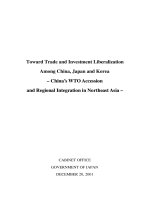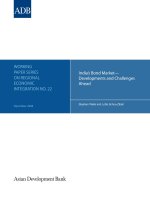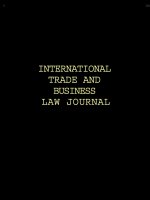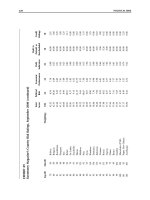Lecture International trade and investment (2/e): Chapter 8 - John Gionea
Bạn đang xem bản rút gọn của tài liệu. Xem và tải ngay bản đầy đủ của tài liệu tại đây (1.3 MB, 29 trang )
Chapter 8
Regional economic integration
NAFTA
EU
(25)
MERCOSUR
F T A A
Copyright 2006 McGraw-Hill Australia Pty Ltd. PPTs t/a International Trade and Investment:
An Asia-Pacific Perspective 2e by Gionea. Slides prepared by John Gionea..
APEC
A F T A
Australia–
New Zealand
8–1
Lecture plan
• Why regionalism?
• Definition of regional economic integration
• Five levels of regional economic integration
– industrial free trade area; full free trade area;
customs union; common market; economic
union
• Trade effects of regional integration
• Regional groups: EU, NAFTA, AFTA, MERCOSUR
• Bilateral free trade agreements
• Is regionalism the path to globalism?
Copyright 2006 McGraw-Hill Australia Pty Ltd. PPTs t/a International Trade and Investment:
An Asia-Pacific Perspective 2e by Gionea. Slides prepared by John Gionea..
8–2
Regional economic integration
• Agreements among countries in a
geographic region to reduce, and ultimately
remove, tariff and non-tariff barriers to the
free flow of goods, services and factors of
production among each other.
• It is estimated that currently there are about
220 regional trade arrangements!
Copyright 2006 McGraw-Hill Australia Pty Ltd. PPTs t/a International Trade and Investment:
An Asia-Pacific Perspective 2e by Gionea. Slides prepared by John Gionea..
8–3
Regional trade arrangements
•
•
Exception to MFN (Most Favoured Nation)
rule in GATT/WTO; allows regional
agreements to provide higher preferential
treatment to members than to nonmembers.
Five levels of regional economic integration
– industrial free trade area
– full free trade area
– customs union
– common market
– economic union
Copyright 2006 McGraw-Hill Australia Pty Ltd. PPTs t/a International Trade and Investment:
An Asia-Pacific Perspective 2e by Gionea. Slides prepared by John Gionea..
8–4
Regional economic integration
Free Trade Area (FTA)
• No tariffs and quotas among members
• National tariffs against non-members
• Partial (industrial) FTA and full FTA
Free Trade
Area
• Australia’s bilateral FTAs with New
Zealand, Singapore, USA, Thailand
• Pluri-lateral FTA: EFTA, NAFTA, AFTA
Copyright 2006 McGraw-Hill Australia Pty Ltd. PPTs t/a International Trade and Investment:
An Asia-Pacific Perspective 2e by Gionea. Slides prepared by John Gionea..
8–5
Regional economic integration
customs union
No tariffs and quotas among members.
Common tariffs operate against non-members.
Customs Union
Free Trade
Area
Examples:
European Community EC (1968)
MERCOSUR (South American Union)
Copyright 2006 McGraw-Hill Australia Pty Ltd. PPTs t/a International Trade and Investment:
An Asia-Pacific Perspective 2e by Gionea. Slides prepared by John Gionea..
8–6
Regional economic integration
common market
Abolition of restrictions on factor movements
Common Market
Customs Union
Free Trade
Area
Example:
The European
‘Single Market’ (1992)
Copyright 2006 McGraw-Hill Australia Pty Ltd. PPTs t/a International Trade and Investment:
Perspective 2e by Gionea. Slides prepared by John Gionea..
© CopyrightAn
J. Asia-Pacific
Gionea
RMIT 2003
8–7
Regional economic integration
economic union
Economic Union
Common Market
Customs Union
Free Trade
Area
Copyright 2006 McGraw-Hill Australia Pty Ltd. PPTs t/a International Trade and Investment:
An Asia-Pacific Perspective 2e by Gionea. Slides prepared by John Gionea..
Characterised by
• harmonisation
and unification of
economic policies
• common
currency
Example:
European Union
8–8
Trade effects of integration
• Trade creation
– trade up through lower-cost goods and
services (e.g. European Union: industrial
sector)
• Trade diversion
– less efficient producers inside the area
replace more efficient external
producers (e.g. EU: common agricultural
policy)
Copyright 2006 McGraw-Hill Australia Pty Ltd. PPTs t/a International Trade and Investment:
An Asia-Pacific Perspective 2e by Gionea. Slides prepared by John Gionea..
8–9
Intra-regional trade under major regional
trade agreements, 2002, $US billion, %
Regional
Trade Agreements
Intra-regional
trade
($US billion)
Share of
World exports
(%)
EU (15)
NAFTA (3)
AFTA (10)
CEFTA (7)
MERCOSUR (4)
ANDEAN (5)
1,509
626
97
19
10
5
24.1
10.0
1.6
0.3
0.2
0.1
Copyright 2006 McGraw-Hill Australia Pty Ltd. PPTs t/a International Trade and Investment:
An Asia-Pacific Perspective 2e by Gionea. Slides prepared by John Gionea..
8–10
Intra-exports as % of total merchandise
exports of selected regional trading
blocs
70
60
50
% of total 40
exports 30
20
10
0
EU
NAFTA
AFTA
Mercosur
1990
64.9
42.6
20.1
8.9
2002
61.6
56.5
24.0
11.5
Copyright 2006 McGraw-Hill Australia Pty Ltd. PPTs t/a International Trade and Investment:
An Asia-Pacific Perspective 2e by Gionea. Slides prepared by John Gionea..
8–11
Intra-imports as % of total merchandise
imports of selected regional trading blocs
70.0
60.0
50.0
% of total 40.0
Imports 30.0
20.0
10.0
0.0
EU
NAFTA
ASEAN
Mercosur
1990
63.0
34.4
16.2
14.5
2002
61.9
38.1
23.6
17.0
Copyright 2006 McGraw-Hill Australia Pty Ltd. PPTs t/a International Trade and Investment:
An Asia-Pacific Perspective 2e by Gionea. Slides prepared by John Gionea..
8–12
European economic integration
1957 European Communities (6): France, Western
Germany, Italy, Belgium, Luxemburg, Netherlands
1968
Customs union
1973
UK, Ireland, Denmark, Greece (1981), Spain and
Portugal (1986)
1992
European single market
1996
Austria, Finland, Sweden
2002
European Monetary Union (currently 12 members)
2004 10 new members: Cyprus, Czech Republic,
Estonia, Hungary, Latvia, Lithuania, Malta, Poland,
Slovak Republic and Slovenia (500 million people).
Copyright 2006 McGraw-Hill Australia Pty Ltd. PPTs t/a International Trade and Investment:
An Asia-Pacific Perspective 2e by Gionea. Slides prepared by John Gionea..
8–13
North American Free Trade
Agreement (NAFTA)
US, Canada, Mexico
• Became law 1/1/1994
• Over 15 year period
– tariffs reduced (99% of goods traded)
– non-tariff barriers reduced
– investment opportunities increased
• Protects intellectual property
• Three-side agreements
– environmental protocols
– labour protocols
– snap-back provision
• Special treatment for many industries
Copyright 2006 McGraw-Hill Australia Pty Ltd. PPTs t/a International Trade and Investment:
An Asia-Pacific Perspective 2e by Gionea. Slides prepared by John Gionea..
8–14
MERCOSUR (Southern Common
Market)
• Originated in 1988 as a free trade pact
between Brazil and Argentina
• Expanded in March 1990 to include
Paraguay and Uruguay
• Combined population of 200 million
• 1995: 5-year plan to move to full customs
union
• Objective: South American Free Trade Area
(SAFTA)
Copyright 2006 McGraw-Hill Australia Pty Ltd. PPTs t/a International Trade and Investment:
An Asia-Pacific Perspective 2e by Gionea. Slides prepared by John Gionea..
8–15
The Free Trade Area of the Americas
(FTAA)
• Old plan of ex-US president George Bush, pursued
now by his son.
• FTAA = 34 nations (including NAFTA and
MERCOSUR members) with population of 880
million; world’s largest free trade area.
• The Quebec 34-country Summit of March 2001
agreed on an FTAA to be launched in 2005.
• President Bush obtained fast-track authority (now
renamed Trade Promotion Authority).
Copyright 2006 McGraw-Hill Australia Pty Ltd. PPTs t/a International Trade and Investment:
An Asia-Pacific Perspective 2e by Gionea. Slides prepared by John Gionea..
8–16
ASEAN (10)
•
•
•
•
•
•
AFTA = ASEAN Free Trade Area; launched in 1992
Members: Singapore, Indonesia, Thailand, Malaysia,
Philippines, Brunei, Vietnam, Burma, Laos, Cambodia (550
million people).
On the Common Effective Preferential Tariff (CEPT) of AFTA,
the 6 founding members agreed (individually) to achieve a
minimum of 85% of the tariff lines on their inclusion lists in the
0-5 % range by 2000, covering 90% of intra-ASEAN trade.
They also brought forward from 2003 to 2002 the date of
implementation of the CEPT; few extensions (e.g cars).
ASEAN + 3 (China, Japan, South Korea).
ASEAN–China FTA: >1.7 billion people; GDP: US$1.65 trill.
Copyright 2006 McGraw-Hill Australia Pty Ltd. PPTs t/a International Trade and Investment:
An Asia-Pacific Perspective 2e by Gionea. Slides prepared by John Gionea..
8–17
MFN simple mean tariffs 1999 vs CEP tariff
rates 1999, 2003, % in selected ASEAN
countries
MFN
1999
CEPT
1999 (%)
CEPT
2003 (%)
Indonesia
10.9
5.85
3.71
Malaysia
7.1
3.17
2.06
Philippines
10.0
4.45
2.06
Thailand
21.6
9.75
4.64
MFN = Most Favoured Nation: non-discrimination.
(All WTO signatories have MFN status.)
CEPT = Common Effective Preferential Tariff: a comprehensive timetable for
gradual phase out of intra-ASEAN tariffs on nominated goods.
Copyright 2006 McGraw-Hill Australia Pty Ltd. PPTs t/a International Trade and Investment:
An Asia-Pacific Perspective 2e by Gionea. Slides prepared by John Gionea..
8–18
Automotive MFN tariffs in selected
ASEAN countries, %
Country
CKD* Tariff
(MFN)
CBU** Tariff
(MFN)
Malaysia
42–80
140–300
Thailand
33
80
35–50
65–80
10
30
42–80
140–300
Indonesia
Philippines
Malaysia
*CKD: Completely Knocked Down car kits
**CBU: Completely Built Units
*
Copyright 2006 McGraw-Hill Australia Pty Ltd. PPTs t/a International Trade and Investment:
An Asia-Pacific Perspective 2e by Gionea. Slides prepared by John Gionea..
8–19
Three-way balance (E. Asia, EU, US)
output, trade with the ROW*, reserves
10,000
* ROW =
Rest of
the World
9,000
8,000
US$ Bln
7,000
6,000
East Asia
EU
US
5,000
4,000
3,000
2,000
1,000
0
Output(WBA)
Output(PPP)
Trade
Reserves
Based on Fred Bergsten’ s Economist article
Copyright 2006 McGraw-Hill Australia Pty Ltd. PPTs t/a International Trade and Investment:
An Asia-Pacific Perspective 2e by Gionea. Slides prepared by John Gionea..
8–20
Why the push for East-Asian
integration?
• East Asian financial crisis
• Failures of WTO and APEC to make
headway on trade liberalisation
• Positive inspiration provided by European
integration (especially the euro)
• Broad disquiet with behaviour of both
the US and EU
Based on Bergsten, 2000. (See References.)
Copyright 2006 McGraw-Hill Australia Pty Ltd. PPTs t/a International Trade and Investment:
An Asia-Pacific Perspective 2e by Gionea. Slides prepared by John Gionea..
8–21
Bilateral Free Trade Agreements (FTAs)
• Singapore’s free trade agreements with
– US, Japan, Australia, New Zealand,
Mexico
• Mexico-European Union
• Australia’s FTAs with
– New Zealand, Singapore, Thailand, USA
(under Australian Senate approval)
• Australian discussions for FTAs with China
and Malaysia
Copyright 2006 McGraw-Hill Australia Pty Ltd. PPTs t/a International Trade and Investment:
An Asia-Pacific Perspective 2e by Gionea. Slides prepared by John Gionea..
8–22
The share of regional trading blocs in
Australia’s merchandise exports 1974,
1989, 2002
Regional Bloc
1974
1989
2002
European Union
16.5
14.4
12.4
NAFTA
12.4
12.5
11.5
ASEAN
8.0
9.6
12.2
MERCOSUR
0.2
0.5
0.6
New Zealand
6.6
5.4
6.6
SAARC
3.4
1.8
3.1
Source: adapted from DFAT, Direction of Trade Time Series,
1974 to 1994 and Composition of Trade, 2003
Copyright 2006 McGraw-Hill Australia Pty Ltd. PPTs t/a International Trade and Investment:
An Asia-Pacific Perspective 2e by Gionea. Slides prepared by John Gionea..
8–23
Is regionalism a path to globalism?
Two key questions:
1. Does regional integration increase or
decrease global economic welfare?
2. Will regional trading blocs lead to global
trade more quickly than the multilateral
process?
Two views
• regional trading blocs = ‘stumbling’ blocs
• regional trading blocs = building blocs
Hopefully, the latter view will prevail.
Copyright 2006 McGraw-Hill Australia Pty Ltd. PPTs t/a International Trade and Investment:
An Asia-Pacific Perspective 2e by Gionea. Slides prepared by John Gionea..
8–24
References
• Bergsten, F. 2000, ‘Towards a tripartite
world’, The Economist,15 July.
• Gionea, J. 2003, International Trade and
Investment, McGraw-Hill, Sydney.
• Hill, C. 2003, International Business,
Competing in the Global Marketplace,
McGraw-Hill, New York.
Copyright 2006 McGraw-Hill Australia Pty Ltd. PPTs t/a International Trade and Investment:
An Asia-Pacific Perspective 2e by Gionea. Slides prepared by John Gionea..
8–25









